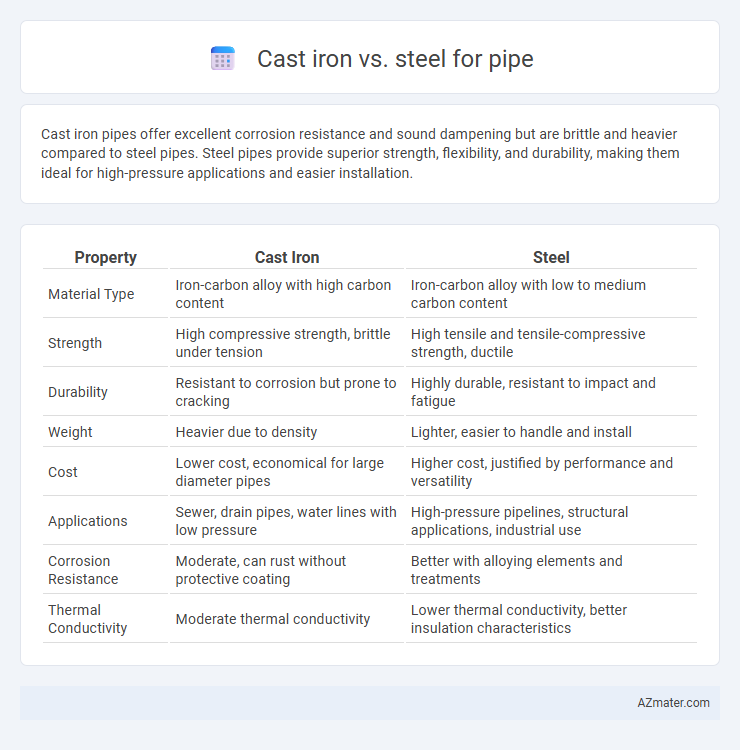Cast iron pipes offer excellent corrosion resistance and sound dampening but are brittle and heavier compared to steel pipes. Steel pipes provide superior strength, flexibility, and durability, making them ideal for high-pressure applications and easier installation.
Table of Comparison
| Property | Cast Iron | Steel |
|---|---|---|
| Material Type | Iron-carbon alloy with high carbon content | Iron-carbon alloy with low to medium carbon content |
| Strength | High compressive strength, brittle under tension | High tensile and tensile-compressive strength, ductile |
| Durability | Resistant to corrosion but prone to cracking | Highly durable, resistant to impact and fatigue |
| Weight | Heavier due to density | Lighter, easier to handle and install |
| Cost | Lower cost, economical for large diameter pipes | Higher cost, justified by performance and versatility |
| Applications | Sewer, drain pipes, water lines with low pressure | High-pressure pipelines, structural applications, industrial use |
| Corrosion Resistance | Moderate, can rust without protective coating | Better with alloying elements and treatments |
| Thermal Conductivity | Moderate thermal conductivity | Lower thermal conductivity, better insulation characteristics |
Introduction to Cast Iron and Steel Pipes
Cast iron pipes, known for their durability and corrosion resistance, have been widely used in plumbing and drainage systems since the 19th century. Steel pipes, characterized by high tensile strength and versatility, are commonly employed in industrial applications, oil and gas transport, and structural frameworks. Both materials offer distinct advantages, with cast iron excelling in noise reduction and longevity, while steel provides superior pressure resistance and flexibility.
Composition and Manufacturing Differences
Cast iron pipes primarily consist of carbon (2-4%) combined with iron and silicon, produced through a casting process where molten metal is poured into molds, resulting in a brittle yet corrosion-resistant material. Steel pipes contain lower carbon content (typically less than 0.3%) and include elements like manganese and chromium, manufactured by either welding or seamless extrusion, offering higher tensile strength and flexibility. The manufacturing of cast iron emphasizes molding and solidification cooling, while steel pipe production involves rolling, forging, or welding to achieve precise mechanical properties and structural integrity.
Durability and Lifespan Comparison
Cast iron pipes offer exceptional durability with a typical lifespan of 50 to 100 years due to their resistance to compression and corrosion. Steel pipes, while also durable, generally have a shorter lifespan of 20 to 50 years because they are more prone to rust without proper coatings or galvanization. The longevity of cast iron makes it preferable for underground plumbing and sewer systems where long-term durability is critical.
Strength and Pressure Handling
Cast iron pipes exhibit high compressive strength and excellent resistance to external loads, making them suitable for low to moderate pressure applications. Steel pipes offer superior tensile strength and can withstand higher internal pressures, making them ideal for high-pressure systems and industrial use. The choice between cast iron and steel depends on the specific pressure requirements and strength demands of the piping system.
Corrosion Resistance and Maintenance Needs
Cast iron pipes exhibit superior corrosion resistance due to their natural oxide layer, making them ideal for underground and wastewater systems, whereas steel pipes are prone to rust without protective coatings or galvanization. Maintenance for cast iron pipes typically involves less frequent interventions, but when corrosion occurs, repairs can be more challenging and costly. Steel pipes require regular inspections and application of anti-corrosive treatments to extend service life and ensure structural integrity in corrosive environments.
Cost and Economic Considerations
Cast iron pipes generally have a higher initial cost compared to steel pipes due to complex manufacturing and heavier weight, leading to increased transportation and installation expenses. Steel pipes offer cost advantages in terms of lighter weight, easier handling, and lower labor requirements, making them economically favorable for long-distance and high-pressure applications. However, cast iron pipes provide superior durability and corrosion resistance, potentially reducing long-term maintenance expenses despite the higher upfront investment.
Common Applications in Industry
Cast iron pipes are commonly used in sewage, drainage, and water distribution systems due to their excellent corrosion resistance and longevity under low-pressure conditions. Steel pipes find extensive applications in oil and gas pipelines, structural support, and high-pressure steam systems thanks to their superior strength, ductility, and resistance to high temperatures. Industrial sectors such as construction, petrochemical, and plumbing often choose pipe materials based on specific operational demands, with cast iron preferred for static or low-stress environments and steel favored for dynamic, high-stress applications.
Environmental Impact and Sustainability
Cast iron pipes have a lower environmental footprint due to their high recycled content and long lifespan, often exceeding 50 years, which reduces the frequency of replacement and waste. Steel pipes, while durable and strong, typically require more energy-intensive production processes, leading to higher carbon emissions during manufacturing. The recyclability of both materials supports sustainability, but cast iron's corrosion resistance and longevity offer a more environmentally sustainable option for water and sewage systems.
Installation and Handling Requirements
Cast iron pipes are heavy and brittle, requiring careful handling with specialized equipment to prevent cracks and damage during installation. Steel pipes, being lighter and more flexible, offer easier maneuverability and faster installation, often allowing welding or threading on-site. Proper safety gear and adherence to weight limits are critical for cast iron, while steel allows more versatile handling but demands precision for secure joints.
Choosing the Right Material for Your Project
Cast iron pipes offer excellent corrosion resistance and sound-dampening qualities, making them ideal for drainage and sewer systems in residential or commercial projects. Steel pipes provide superior tensile strength and durability, suitable for high-pressure applications like water supply, gas lines, and structural installations. Selecting the right material depends on project requirements, including environmental conditions, pressure ratings, budget, and longevity expectations.

Infographic: Cast iron vs Steel for Pipe
 azmater.com
azmater.com